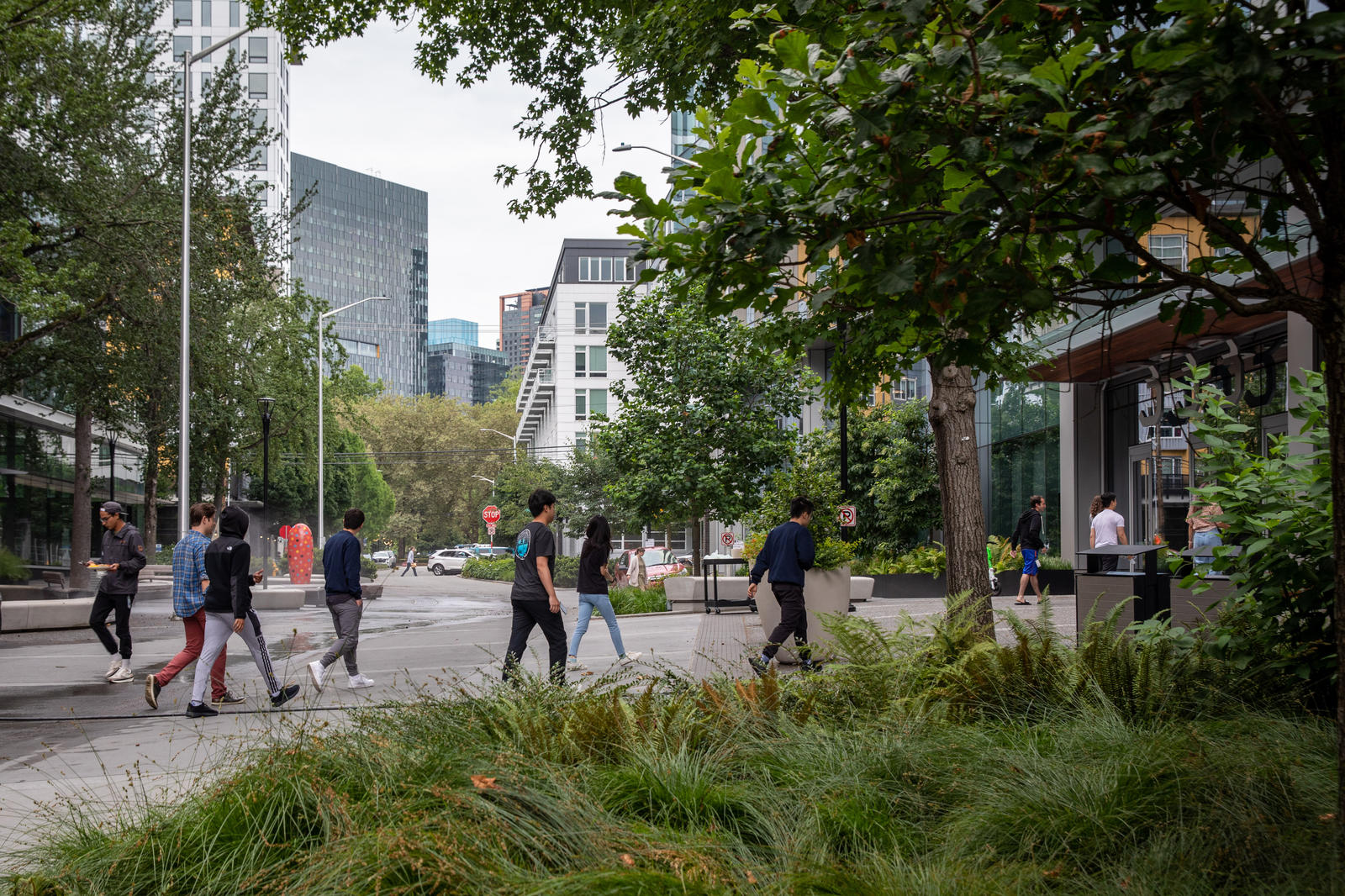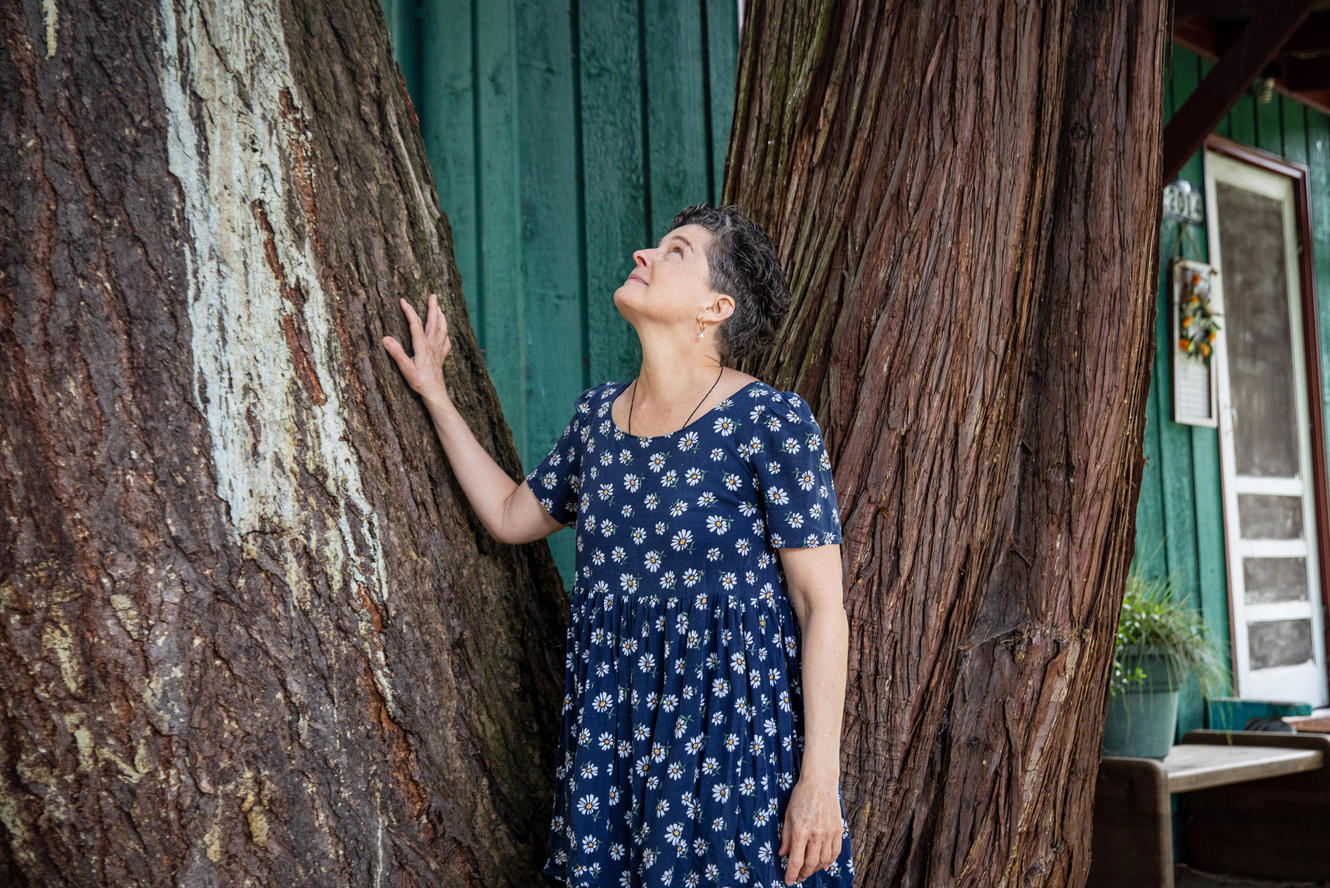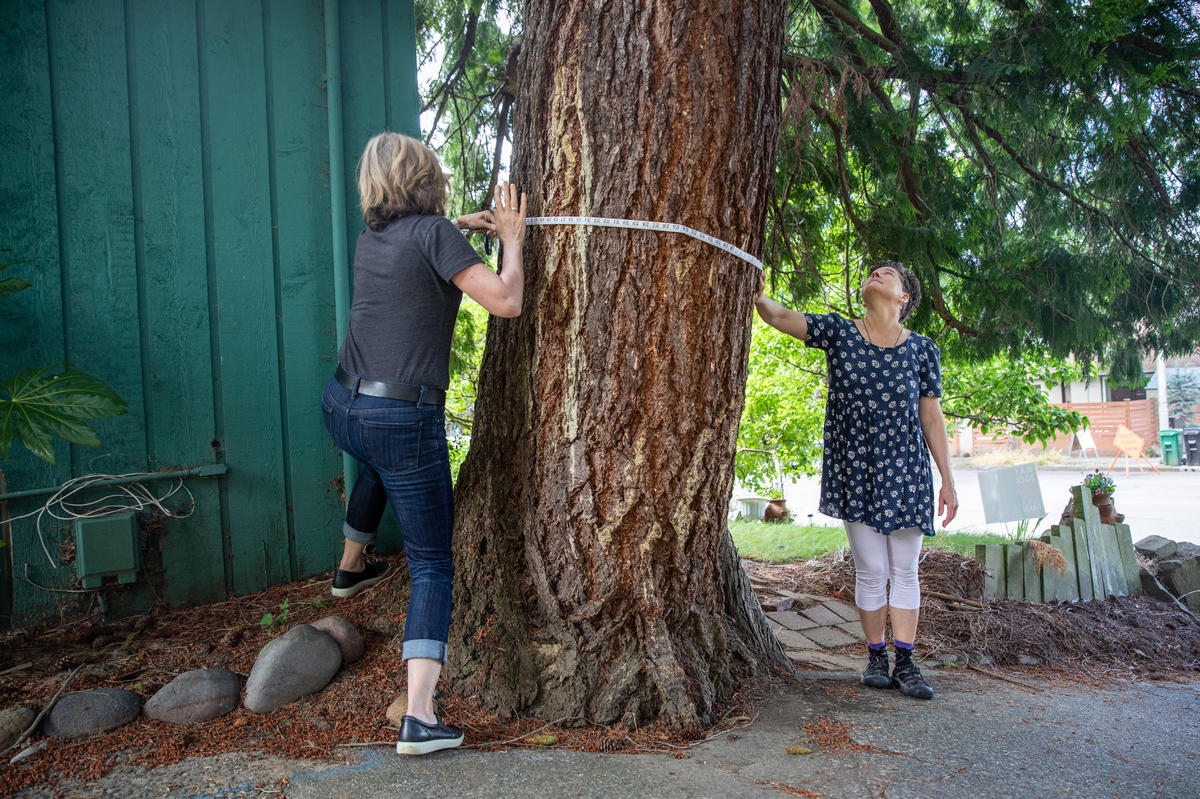Because the majority of the region’s trees are in residential neighborhoods, responsibility for maintaining canopy coverage is shifting to homeowners.
By Lizz Giordano / Crosscut.com / August 31, 2022
Some people call them the True-Love Trees. Part Douglas fir, part western red cedar that sprouted from seeds likely dropped by a hungry rodent so close together that they grew into one – with two trunks each measuring more than 3 feet across.
These exceptional trees in the Meadowbrook neighborhood of North Seattle – officially designated as such because of Seattle’s tree code and their 40-inch diameter – epitomize Seattle in another way, too. These trees have become the focus of a save-the-trees-from-development campaign because they sit on a plot of land where two small houses built in the late 1920s are about to undergo redevelopment, tripling the number of households able to live on that piece of land.
Trees can be important figures in people’s lives, said Sandy Shettler, a member of the group The Last 6,000, a reference to the 6,338 or so remaining trees with a 30-inch or larger trunk diameter that were still standing in the city, according to a 2016 tree study.
They’re valuable to more than just the people who are lucky enough to live nearby. These large trees also help the city combat climate change by absorbing stormwater and carbon dioxide, and their canopies lower air temperatures.
City governments around Puget Sound tasked with growing while also preserving urban tree canopies are in the process of reforming laws to strike a balance between retaining existing trees but not hindering development. With a majority of these trees living in residential neighborhoods, cities are trying to shift more of the responsibility for maintaining the canopy to homeowners, with both rules and incentives.
Shifting responsibility
Current Seattle rules require that every exceptional tree – those 30 inches or larger in diameter, like the True-Love Trees – lost during development be replaced. But there are no guidelines for the size of those new trees.
“Current tree replacement rules require tree replacement which, upon maturity, would result in the canopy cover equal to the canopy of the tree removed,” said Wendy Shark, a spokesperson for Seattle’s Department of Construction and Inspections, in an email. “This could be satisfied by planting one smaller tree so long as it would, upon maturity, have a canopy equal to what was removed.”
Hazardous and diseased trees can be removed without penalty. Trees smaller than 30 inches in diameter can also be considered exceptional, depending on the species.
“There’s no consideration for the size of the tree that’s being lost,” said Julia Michalak, a research scientist at UW who specializes in climate-change adaptation and landscape planning and is co-chair of Seattle’s Urban Forestry Commission, a group established to advise the mayor and the city council on these issues.
“If you’re losing a really big tree and replacing it with a really small new tree, then that’s a huge loss and ecosystem benefits,” Michalak said. “There’s a lot of desire to protect big old trees and also, even the medium or smaller sized trees that take so long to grow. We really need to be protecting the trees that we have.”
The Urban Forestry Commission wants to see an inch-for-inch replacement, requiring more trees the larger the one being removed is.
Trees will be removed as new housing gets built, Michalak added, so “what we want to see is a very aggressive push towards replacing those trees if they have to be lost through that development process.”
For more than a decade, Seattle has operated under an interim tree code. Moves to update the tree code have fizzled out with each passing administration.
It’s something that a lot of people haven’t wanted to touch, said Josh Morris, an urban conservation manager for the group formerly known as Seattle Audubon and the other co-chair of the city’s Urban Forestry Commission.
“The focus has been on reducing barriers and speeding up processes for development, which is really important, because we do have such an extreme housing shortage,” said Morris. “And trees and protecting them is an extra barrier.”
Earlier this year, the Seattle City Council started taking up some of the recommendations put forward by the Commission in 2019. The slate of proposed reforms includes lowering the threshold for exceptional tree designation to 24 inches and includes the Commission’s recommendation of an inch-for-inch replacement.
The draft code also sets protections for smaller trees lost in development. The Urban Forestry Commission pushed for the new rules to cover trees with diameter down to 6 inches; the draft ordinance proposed by Seattle Department of Construction and Inspections ultimately settled on 12 inches.
If these reforms are adopted, it would mean new regulations for preserving and replacing an additional 70,400 trees with at least a 12-inch trunk diameter, 22,400 of which are 24 inches or greater, a report by Seattle Department of Construction and Inspections estimated.
A new canopy assessment found the city lost 255 acres of its tree canopy, roughly the size of Green Lake, in the past five years. As Seattle’s tree canopy shrunk by 1.7% the city’s population grew by 8.5%. The city had set a goal of 30% tree canopy cover by 2037, but it was just 28.1% in 2021. Most of the loss in recent years occurred in parks and natural areas due to hotter weather, an aging tree population and thinning of deciduous trees to make room for conifers.
But single-family areas saw the second highest loss in canopy acreage. Neighborhood zones include the largest share of the land, covering 67% of the city and containing 72% of Seattle’s tree canopy, according to city data.
A lot of the focus has been planting trees in public spaces, said Sharon Leishman, director of Duwamish Alive Coalition. “Which is good. But there’s only so much public land we can do that on realistically.”
It’s also going to take shifting responsibility to homeowners where much of the city’s trees and canopy exists, Leishman said, while also pushing to preserve existing mature trees.
While it’s great to add small trees, those are being planted for the future, Leishman added. The large trees are what’s doing the heavy lifting now, the mature trees that are giving the city immediate benefits.

Density, often posed as an enemy of trees, in some cases can result in more trees, says Weston Brinley, pointing to South Lake Union and Denny Triangle neighborhoods.“They’ve had more growth and development than anyplace in the region. And huge, huge canopy increases, conversion from parking lots to a more tree hospitable neighborhood.” (Lizz Giordano for Crosscut)
Across Lake Washington
Not everyone sees preserving and growing tree canopies the duty of the private citizen. Toby Nixon, a councilmember in Kirkland, was one of two no votes this spring against strengthening that city’s tree code.
“If we want to protect trees, we should compensate their owners for that. And the problem is with limiting the trees that can be cut down, we limit what people are able to do on their property,” Nixon said. “If the city wants to control some property, they should buy it. Same with the county. Same with the state.”
A 2018 study found Kirkland’s tree canopy had fallen a little below the city’s comprehensive plan’s goal of 40%. In the affluent city along Lake Washington’s east side, much of the tree loss is happening because of development in single-family residential areas, according to Adam Weinstein, the city’s director of the Planning and Building Department.
“We found the trees that were being removed at higher rates were the really big ones,” Weinstein said. “And so that led us to create new requirements for retaining the bigger trees.”
Kirkland’s new tree code settled on 26-inch diameter for special status for their “landmark” trees, and strengthened the standards for removal and replacement of trees 6 inches in diameter or larger. The new rules also increase the number of replacement trees required to correspond with the larger the width of the one being lost. The rules also allow a fee-in-lieu option.
The updated code also granted variances over certain building requirements such as rules regarding setbacks, parking, yard sizes or building height, if developers worked around trees. Developing and passing the new regulations took Kirkland several years.
“We approached the code, trying to strike a balance between environmental protection and development,” Weinstein said. “Tree codes really bring out the competing interests in land use policy and environmental protection. You really want both, right? A good city wants both.”
The Master Builders Association of King and Snohomish Counties has challenged these moves to strengthen tree codes, saying Kirkland’s new tree codes hinder the building of new housing by making “development more expensive, uncertain and problematic.”
In an appeal to the Growth Management Hearing Board, the group claims the new rules create a nearly total ban on removal of landmark trees on private property in Kirkland.
“There’s a lack of consideration of property rights. Kirkland street ordinance places a disproportionate regulatory burden on property owners to achieve the citywide canopy goal 40%,” said Jennifer Anderson, the Master Builders’ interim director of government affairs. “There’s very little mention of trees and public property and no identifications of methods by which the city will contribute to attaining the tree canopy goals.”
She said the new tree code still adds time and uncertainty to projects, and now applies to even more trees.
The Master Builders also filed an appeal with a hearing examiner over Seattle’s decision that the proposed tree code would have no significant impact on the environment and thus no environmental impact statement is needed. The group lost that challenge.
What makes a tree exceptional?
Shoreline, another city that reworked its tree code recently, decided landmark trees are those 24 inches in diameter and greater and now requires three replacement trees for every one removed.
There’s nothing special about 24 inches versus 26 inches, rather it’s a proxy for a tree that has survived for a long period of time, says Weston Brinkley, an urban environmental scholar who works with municipalities and institutions to manage natural resources in cities. “And therefore, we are somewhat confident and will continue to survive.”
Private property is where a majority of the current trees are, said Brinkley. It’s where potential planting space is and it’s where the majority of trees are being lost outside of parks.
If Shoreline wants to reach the goal of 30% canopy coverage, it’s going to have to happen on private property, said Brinkley, who is also a former member of the city’s urban forestry commission.
“The majority of the canopy being lost in development is being lost on single family lots where we are replacing one housing unit with one housing unit. Therefore, a majority of the trees being lost have nothing to do with increased density.”
“It’s a lose-lose in that sense,” he added. “We’re not meeting our housing goals. We’re not gaining tree canopy.”
Density – often posed as an enemy of trees – sometimes can result in more trees, Brinkley said, pointing to South Lake Union and Denny Triangle neighborhoods.
“They’ve had more growth and development than anyplace in the region. And huge, huge canopy increases,” Brinkley said. “A conversion from parking lots to a more tree hospitable neighborhood.”
The recommendations from Seattle’s Urban Forestry Commission, like Kirkland’s, also contain additional carrots for developers to encourage preserving mature trees and a fee-in-lieu of planting on or off site. So far the only tree code update approved by the Seattle City Council establishes a mandatory arborist registration system and requires homeowners to post notice of major pruning or removal before it happens.
“We get lots of complaints from constituents of tree cutters coming in on the weekends or in the middle of the night and taking out trees having unmarked vans. And nobody knows who they were,” said Seattle Councilmember Alex Pedersen. “We sort of ended the Wild West of tree cutting by implementing the registration bill, increasing transparency and accountability for these tree service providers.”
The challenge by the Master Builders’ group froze other council action on the tree code, said Pedersen, who’s been working with Councilmember Dan Strauss to update the tree code.
“We really need the new administration to take the loss of tree canopy seriously in the face of climate change and to start viewing trees as vital infrastructure for the resiliency of our city,” he said.
Pedersen thinks it’s going to take the city both preserving and planting more trees on both private and public land to grow the canopy coverage.
“We need to disincentivize real estate developers from just clear-cutting every lot that they want to develop and to protect trees that provide a public benefit,” Pedersen added.
Rarely there’s success in the tree saving world, says Shettler of The Last 6000, but this year she’s helped rack up some big wins, preventing the removal of two exceptional specimens with trunks greater than 2 feet in diameter from eradication. The roots of one were in the way of a new curb ramp that Seattle’s Department of Transportation wanted to install in West Seattle. The other, in Seward Park, was set for removal during a remodel of an existing single-family house, according to the South Seattle Emerald.
Usually a neighbor reaches out to Shettler and the group, The Last 6,000, just hours before, or after, removal begins – often much too late for any chance of saving the tree. When Shettler learns of pending development with time to fledge a full blown campaign, The Last 6000 can rally even before the property is sold.
The Last 6,000 says there’s a way to arrange the maximum number of units that also saves the exceptional trees on the site. If Shettler can’t save this tree from the chopping block, she doesn’t have a lot of hope for others.
There’s a way for the developers to get maximum density here, she says, but also save the trees. “Maybe this is the one that won’t have a sad outcome.”
A recently filed construction permit by Legacy, the developer working on the project for the parcel in the northwest part of the city, describes a different future for the trees: “Removal of the trees, to allow maximum density on the site.” Legacy didn’t respond to multiple emails or phone messages.
“The bigger they are, the more we need to work around them, we need to co-exist,” said Rivers Dysart, the renter who has lived beneath the branches of these intertwining trees for nearly a decade and a half.
FEATURED IMAGE: Rivers Dysart has lived beneath the branches of the Meadowbrook’s True-Love trees for nearly a decade and a half. Dysart is part of a push to save the massive trees as the parcel of land undergoes redevelopment. (Lizz Giordano for Crosscut)
Visit crosscut.com/donate to support nonprofit, freely distributed, local journalism.




